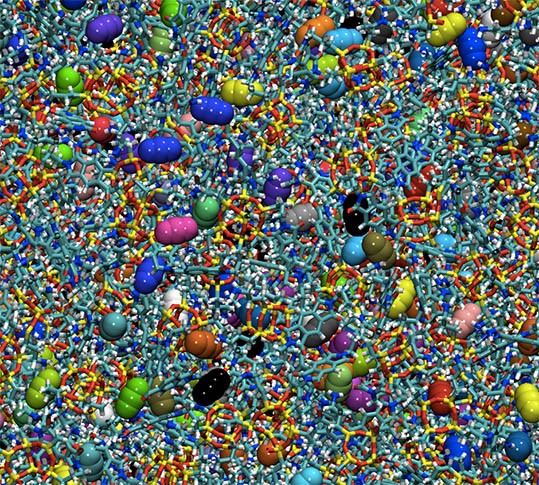
The “Organic Materials with Specific Properties” team, from the Laboratory of Electrochemistry and Physicochemistry of Materials and Interfaces conducts research on the design, the implementation and characterization of high added value materials.
These materials, and in particular complex polymers, are also the subject of molecular modeling projects for which MUST’s high performance computing (HPC) resources are used.
Molecular modeling of complex polymer materials

POSS-imide polymer system containing CO2 molecules
As part of its work in molecular modeling, LEPMI studies, at the atomic level, the microstructure and transport phenomena within complex polymer materials.
To do this, the researchers mainly use two simulation techniques: the Molecular Dynamics (MD) and Monte Carlo (MC) methods. The Density Functional Theory (DFT) type methods are also used to optimize the parameters of the force-fields.
Laboratory studies focus on the separation of compounds thanks to their differentiated gas permeation within polyimide membranes, the structure of organic/inorganic materials such as [“polyhedral oligomeric silsequioxanes” (POSS)](http: //www.lmops. univ-smb.fr/brown/testLQ_3.mpg), and the high temperature and high pressure properties of hyper-crosslinked POSS-imide networks. These materials are particularly interesting because their energy cost is very moderate compared to other gas separation methods such as cryogenics. From an application perspective, LEPMI strives to bring its modeling work at the atomic level closer to the conditions of industrial use.
In order to improve the tools available to the modeler and to give more credit to the results obtained, methodological contributions on the solubility, diffusion and separation of gas mixtures by polymer membranes and organic-inorganic hybrids are developed. These developments, tested on MUST, are systematically implemented in all of the LEPMI molecular modeling calculation codes.
Contact : David BROWN or Sylvie NEYERTZ